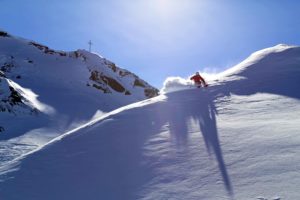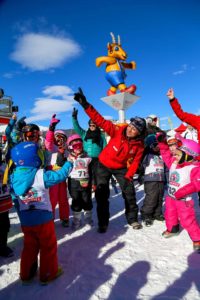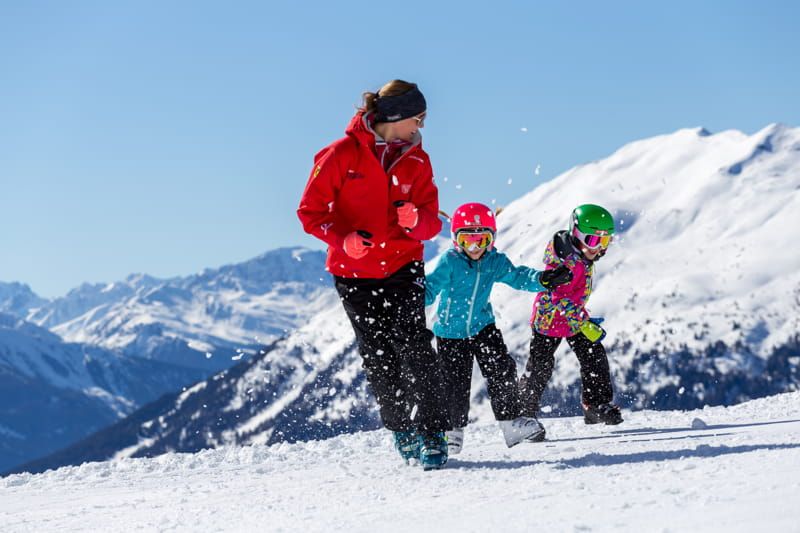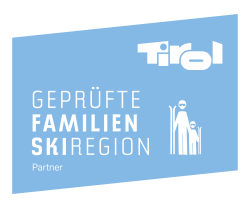How to protect you and your children from injuries while skiing and stay safe on the slopes
A skiing holiday with the family should not only bring fun, family time together and relaxation, but you should also make sure you are safe on the ski slopes. But what is the best way to protect yourself from injuries?
In this blog article, we inform you about a few worthwhile tips that can help you reduce and minimize the risk of injuries in the snow.
1. The right equipment for skiing
The right equipment and clothing are very important factors for skiers’ safety on the slopes. Appropriate equipment and equipment that corresponds to your skiing ability play a crucial role in avoiding injuries.
Ski clothing should protect, both children and adults from cold and wet, and should be breathable and water-repellent.
We have written a detailed blog about this topic with the title “The right equipment for the ultimate skiing experience: Tips for the right ski equipment!”
A helmet and gloves are also essential for a safe ski day. The helmet protects the head. Please note that hair clips or similar items can be painful under a helmet. In case of falling, these things also harm head protection.
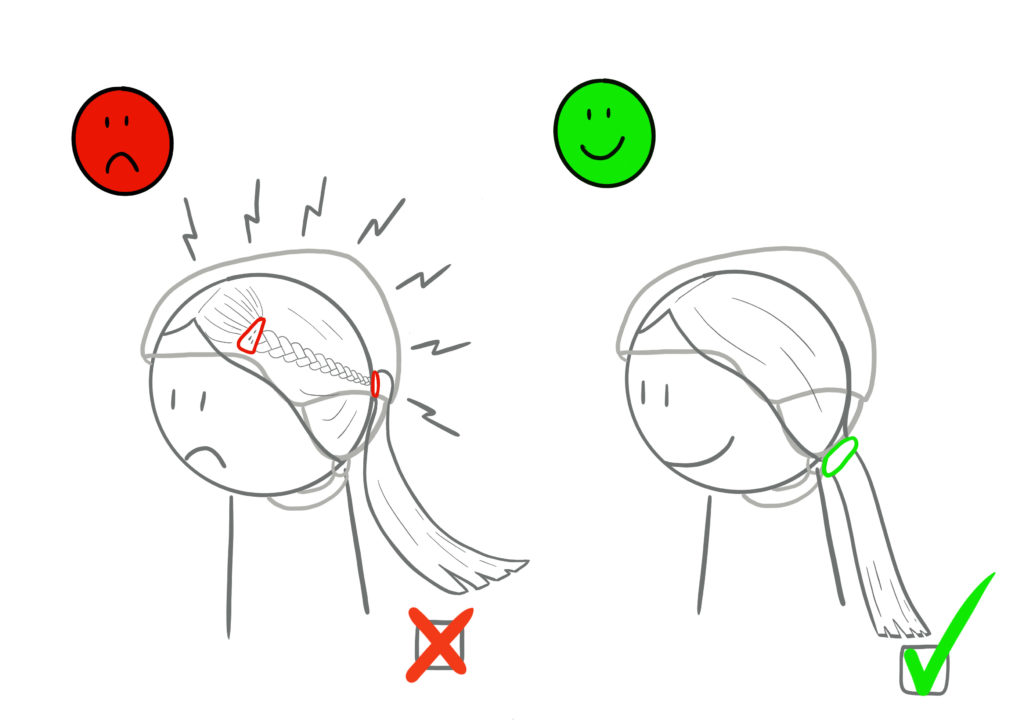
Gloves are also a “must-have” of appropriate ski clothing. These not only keep your hands warm, they also protect against abrasions in case of a fall and they also protect the hands against cuts that can be caused by the sharp edges of the skis. As an option, wearing a back protector is of course also recommended, especially if you ski in the backcountry or the snow park.
You should not forget that the eyes and skin also need protection. To protect your eyes from UV rays and intense sunlight, it is necessary to wear sunglasses or ski goggles. A sunscreen with a high sun protection factor must be applied to the skin, even in cloudy weather. UV radiation exists even without direct sunlight and to avoid painful and unpleasant sunburn, you should not forget to protect your skin.
It is worth paying attention to the right ski equipment to have a safe and eventful ski holiday with your whole family.
2. Warm-up
Warming up before skiing is very important to optimally prepare the muscles and joints for the upcoming stress and to reduce the risk of injury. It’s tempting to jump straight into skiing, but investing a few minutes into a targeted warm-up can make the difference between a normal day of skiing and a fantastic day of skiing.
3. Ski courses as the base for a safe skiing experience
Professional ski instructors not only teach you the correct skiing technique and give valuable tips on how to behave correctly on the slopes but also point out alpine dangers and train their guests in recognizing the dangers. They learn how to avoid dangerous spots.
Especially if you are skiing with children, it is important to ensure that children are not overwhelmed. In the ski course, children learn and improve their skiing skills step by step. If you want to ski together with your children after the ski course, the ski instructor will be happy to recommend you the slope, which is best suited to your child.
In the afternoon, of course, the condition of the children must be taken into account. It is therefore advisable not to take the most difficult slope when both children and adults are getting tired at the end of the ski day.
4. Safety tips when skiing with children
In addition to the right equipment, it is also important that the child’s skiing skills are always realistically assessed and that the child is not overwhelmed. Driving on slopes that are too difficult can unsettle the child and of course, increase the risk of falling and injuries. You should always ski step by step so that your child doesn’t lose his or her confidence and feels safe.
The little skiers should also learn that they must be able to stop at any time and that other skiers and snowboarders must be taken into consideration (FIS rules).
There is a FIS rules slope in the ski area Hochzeiger, that teaches children the FIS rules in a child-friendly way. These FIS rules are rules of conduct on the slopes and are comparable to road traffic regulations.
Dangerous overtaking manoeuvres and too little distance must be avoided. It is necessary to drive with foresight when skiing with children.
When stopping on the slopes, you should always be visible to all other winter sports enthusiasts.
For better recognition of children on the slopes, our ski school offers security vests for all children on the ski courses (especially for beginners and slightly advanced skiers).
5. Breaks
Skiing can be tiring, especially if you don’t use the right skiing technique. It is very important to make sure that enough breaks are taken. Excessive fatigue and poor concentration significantly increase the risk of falling down and thus the risk of injuries.
6. Respect piste markings, information boards, barriers and the FIS rules
Skiing off-piste is often underestimated and children in particular often have a lack of awareness of the dangers. Piste markings, information boards and barriers must be strictly respected and closed slopes must not be used. The ski area operators have important reasons when slopes are closed and these must be followed at any time.
When skiing in the backcountry away from the secured slopes a variety of possible alpine dangers must be taken into account. The most well-known danger in the backcountry is an avalanche.
Partially snow-covered rivers, fences from farming in summer, and tree stumps pose a danger to skiing in the backcountry, as do falling rocks. For freeride or off-piste runs in the open ski area, it is therefore highly advisable to book a ski guide.
FIS rules, as mentioned in the fourth paragraph, are general rules of conduct of the International Ski Federation (FIS). These rules are comparable to the road traffic regulations and apply to skiers, snowboarders and other winter sports enthusiasts on all ski slopes and cross-country trails.
1st rule: Respect for others
Every skier, snowboarder or other winter sports participant must behave in such a way that they do not endanger or prejudice others.
2nd rule: Control of speed and skiing or snowboarding
A skier or snowboarder must move in control. He must adapt the speed and manner of skiing or snowboarding to his ability and the prevailing conditions of terrain, snow and weather as well as to the density of traffic.
3rd rule: Choice of route
A skier or snowboarder coming from behind must choose his route in such a way as not to endanger skiers or snowboarders ahead.
4th rule: Overtaking
A skier or snowboarder may overtake another skier or snowboarder above or below and to the right or to the left provided that he leaves enough space for the overtaken skier or snowboarder to make any voluntary movement.
5th rule: Entering, starting and moving upwards
A skier or snowboarder entering a marked run, starting again after stopping or moving upwards on the slopes must look up and down the slopes so that he can do so without endangering himself or others.
6th rule: Stopping
Unless necessary, a skier or snowboarder must avoid stopping on the slope in narrow places or where visibility is restricted. After a fall in such a place, a skier or snowboarder must move and clear the slopes as soon as possible.
7th rule: Climbing and descending on foot
A skier or snowboarder, climbing or descending on foot must keep to the side of the slope.
8th rule: Pay attention to the signs
A skier or snowboarder must respect all signs and markings.
9th rule: Assistance
In accidents, every skier or snowboarder is duty-bound to assist.
10th rule: Identification
Every skier or snowboarder and witness, whether a responsible party or not, must exchange names and addresses following an accident.
7. First aid measures in case of injury
Of course, even if you follow all the rules, you can still be involved in an accident at any time. Here, too, there are some things that you should know and that should be taken into account.
A very helpful tip is to save the telephone number of the piste rescue service in your mobile phone before you start your ski day or at least carry a brochure of the ski area with you. Normally there the telephone number of the piste rescue service is written down.
You can find more information about the correct behaviour in the event of an accident in our blog: Safe in the Mountains – what to do in the event of a skiing accident.
Conclusion
There are many points that you can use to protect yourself and your entire family on the slopes. The right equipment and clothing are important factors for safe skiing fun, but the correct behaviour on the slopes also contributes to a successful day of skiing with the entire family.
If you pay attention to the points mentioned above, you will have an unforgettable and injury-free skiing holiday!
See you on the slopes!



